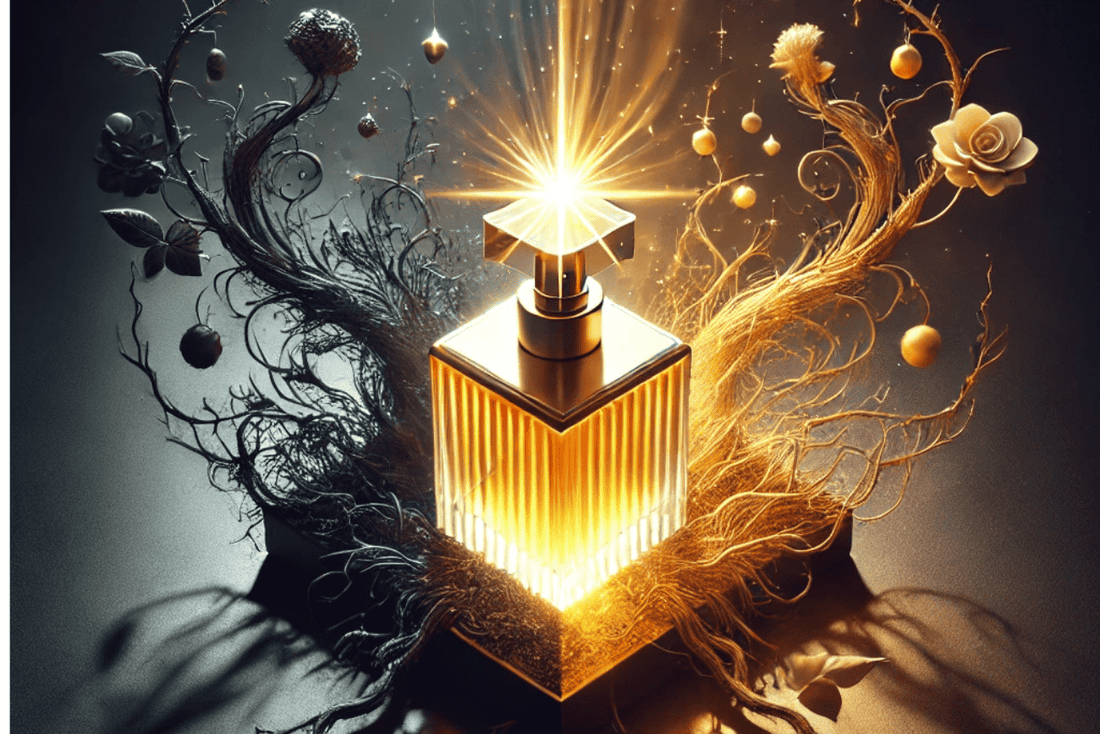
The ambivalent nature of patchouli: curse or gift?
Share
Repellent, sensual, magnetic, evoking extreme emotions… One thing is certain: patchouli cannot be described as plain or neutral. It divides perfume lovers and users into two camps: some are enchanted by its exotic notes, while others are repelled by its musty scent. There is likely no other ingredient in perfumery that stirs such a wide range of emotions. This is precisely why patchouli boasts a unique history: from entering royal salons, falling into disrepute, to a renaissance and reigning once again among fragrance notes.

What is Patchouli?
Let’s start with the basics. Patchouli is a plant (a semi-shrub) from the mint family, cultivated in tropical regions of Asia, such as Indonesia, the Philippines, and Malaysia. Its leaves are used to produce essential oil. Interestingly, fresh patchouli leaves are odorless. Only through the processes of drying and subsequent fermentation is their extraordinary aroma released. Experts classify the scent of patchouli in the woody-green category. Its intoxicating, intense aroma is characterized by high longevity and projection. It is decidedly not a light, floral scent that will appeal to everyone. Initially, it’s somewhat sweet and grassy, but over time it develops a woody depth with a wine-like nuance. Patchouli reveals its full potential as part of a fragrance composition, blending perfectly with sandalwood, rose, lavender, or myrrh. It works exceptionally well as a fixative for lighter notes, which is why it is most often found among base notes.
The Arrival of Patchouli in Europe
How did patchouli’s great journey to Europe begin? In the 19th century, patchouli arrived on the old continent serving as a moth repellent. It was discovered that its scent effectively deterred moths, so it was used to treat cashmere and silk fabrics imported from India. Over time, it became apparent that some shawls sold better than others, and their popularity wasn’t due to their appearance but rather the scent of the material. From that point on, patchouli began to conquer not only the hearts of the bourgeoisie but also made a bold entrance into royal courts. French aristocracy was captivated by the scent, which was entirely different from what they had known: sweet, reminiscent of camphor, and above all, incredibly sensual, even “dirty.” In the 19th century, patchouli began to appear as an ingredient in luxury perfumes, emphasizing the oriental and exotic inspirations that were dominant at the time. As a result, patchouli became a fashionable and desirable scent among the upper classes.
However, fashion tends to change. Over time, patchouli’s reputation suffered. It was considered intrusive, headache-inducing, and it negatively impacted women’s image, stripping them of an air of innocence. Patchouli fell from the grandeur of royal courts to the bedrooms of courtesans, who enthusiastically embraced this ostentatious yet highly durable fragrance, known as the “scent of love.”

Patchouli in the 20th Century
At the beginning of the 20th century, patchouli gained new significance in the world of perfumery. It began to be used more consciously and with greater finesse in fragrance compositions dominated by oriental inspirations. However, in later decades, patchouli, being a heavy and complex scent, was sometimes approached with caution, especially in lighter, more modern compositions that gained popularity after World War II. The 1950s and early 1960s were dominated by fresher, floral, and aldehydic fragrances, such as the iconic "Chanel No. 5", which sometimes marginalized patchouli.
Patchouli experienced a revival in the second half of the 1960s. It gained immense popularity during the hippie cultural revolution. Its scent perfectly embodied the spirit of rebellion against traditional cultural notions of femininity and masculinity, as well as a connection to Oriental spirituality and a desire to reunite with nature. In the 1970s, patchouli had two faces: on one hand, it symbolized an alternative lifestyle associated with untidiness and a lack of hygiene, while on the other, it was a key ingredient in many classic, fashionable fragrances like "Aromatics Elixir" by Clinique or "Opium" by Yves Saint Laurent.
The 1980s marked an era of opulence, excess, and bold, intense fragrances. Perfumes became more expressive and multidimensional, aligning perfectly with the style of the decade—loud, bold, and glamorous. Patchouli, known for its earthy depth and sensuality, fit these trends beautifully and was often combined with equally intense ingredients like sandalwood, musk, or spices. One of the most iconic fragrances of that era was "Obsession" by Calvin Klein (1985), where patchouli played a significant role in the backdrop of oriental notes.
Meanwhile, at the dawn of the 1990s, the approach to perfumes shifted. The perfume market was once again dominated by lighter, fresher fragrances. Patchouli was pushed into the background, becoming a subtle undertone in perfumes dominated by light, citrusy aromas.
Patchouli in the 21st Century
In the 21st century, patchouli has made a comeback, but in a more refined and versatile form. Thanks to modern extraction and distillation techniques, perfumers have been able to showcase various facets of patchouli, leading to its immense popularity, particularly in niche compositions. Today, more and more perfume brands are committing to sustainable sourcing of raw materials, and patchouli—primarily cultivated in Indonesia—has become a symbol of responsible production in the fragrance industry.
Conclusion
The history of patchouli in perfumery is a true rollercoaster. From its early popularity in French royal courts to its fall in the decadence of courtesans, its revival in the 1970s, decline in the 1990s, and its innovative use in the 21st century, patchouli has come a long way in the world of fragrances. Today, thanks to diverse production techniques and changing scent preferences, patchouli is more versatile than ever. It features in both heavy, sensual compositions and lighter, fresher fragrances. Patchouli has become a symbol of longevity and depth, embodying history, nature, and modernity in perfumery, delighting the most sophisticated and discerning noses.

